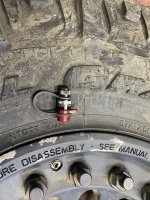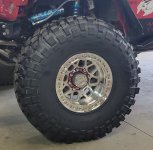You are using an out of date browser. It may not display this or other websites correctly.
You should upgrade or use an alternative browser.
You should upgrade or use an alternative browser.
Fittings for airing tires up and down?
- Thread starter dcyrilc
- Start date
There are lots of different tools and options available but for me personally, I like using a deflator like this because it's really fast. Essentially, pulls the core out, keeps it from getting lost and has a pressure gauge that you can check with ease.
I should also note that I like the analog gauge as opposed to digital if only because the later is useless when the batteries die.
For filling back up, again, there are lots of compressors available and your budget and what you're willing to carry will ultimately be your deciding factor. Again, me personally, I like this option best
I should also note that I like the analog gauge as opposed to digital if only because the later is useless when the batteries die.
For filling back up, again, there are lots of compressors available and your budget and what you're willing to carry will ultimately be your deciding factor. Again, me personally, I like this option best
Last edited:
Upvote
0
Ddays
Hooked
I have used several different deflators and honestly for me, I find it easier & faster to just take the damn valve cores out with a cheapo core tool and throw a gauge on it now and again to check. I have a container of spare cores in a small case if I lose one but so far so good.
Depending on your tire size, a single compressor works fine. If you're on 37's or up maybe a twin if you're dropping down to single digit pressures. Mostly it's a time thing.
Depending on your tire size, a single compressor works fine. If you're on 37's or up maybe a twin if you're dropping down to single digit pressures. Mostly it's a time thing.
Upvote
0
CalSgt
Hooked
I had money burning a hole in my pocket so I installed the Powertank "Power valves", in now way are they necessary but they sure do make airing up and down faster. Another benefit is when airing up at the trailhead I hook the compressor to one valve stem and clip a gauge on the other, I'm able to keep an eye on the pressure while I complete other tasks like cleaning the windshield and tying things down before I get on the highway.
I noticed the valve stems on the JL's with the TPMS sensors have 2 tiny holes drilled on the sides for air to pass through. The small holes don't make much difference when airing up with a 12v pump, but when filling tires at home with my big 220v shop compressor it seemed to take forever squatted next to the jeep for several minutes per tire.
I noticed the valve stems on the JL's with the TPMS sensors have 2 tiny holes drilled on the sides for air to pass through. The small holes don't make much difference when airing up with a 12v pump, but when filling tires at home with my big 220v shop compressor it seemed to take forever squatted next to the jeep for several minutes per tire.
Upvote
0
Ddays
Hooked
Full disclosure - I do have a set of APEX valves on one of my sets of tires and they are pretty sweet. Very similar to the Monster Valves. I was a little leery of them for a while but they seem to be holding up well. (I have a spare set in case I ever have an issue with one or more)I had money burning a hole in my pocket so I installed the Powertank "Power valves", in now way are they necessary but they sure do make airing up and down faster. Another benefit is when airing up at the trailhead I hook the compressor to one valve stem and clip a gauge on the other, I'm able to keep an eye on the pressure while I complete other tasks like cleaning the windshield and tying things down before I get on the highway.
I noticed the valve stems on the JL's with the TPMS sensors have 2 tiny holes drilled on the sides for air to pass through. The small holes don't make much difference when airing up with a 12v pump, but when filling tires at home with my big 220v shop compressor it seemed to take forever squatted next to the jeep for several minutes per tire.
Upvote
0
GP NOIR
Hooked
I use a hose that connects to all four tires at once with a digital tire gauge. Open the valve to let air out. Close the valve to check pressure.
To air up, the hose connects to all four tires and the compressor. Turn on the compressor, open the valve to inflate the tires. Close the valve to check pressure.
What I like about the system is I only have to watch the pressure once, not four times (once each tire). The system has its pros and cons and for me, the pros outweigh the cons.
To air up, the hose connects to all four tires and the compressor. Turn on the compressor, open the valve to inflate the tires. Close the valve to check pressure.
What I like about the system is I only have to watch the pressure once, not four times (once each tire). The system has its pros and cons and for me, the pros outweigh the cons.
Upvote
0
waynem
Member
Apex valves are really fast .. but they are fairly tall and depending on your wheels, if they aren't protected they are prone to being snapped off by rocks and branches. I ran Hutchinsons for a while and they are shallow and the valve stem isn't very well protected. I snapped one Apex valve off in the middle of the Rubicon. Fun times breaking down the beadlock at camp to replace it; thankfully I had a spare valve. I would definitely run them again if I had deeper wheels.I do have a set of APEX valves

Upvote
0
Ddays
Hooked
Apex valves are really fast .. but they are fairly tall and depending on your wheels, if they aren't protected they are prone to being snapped off by rocks and branches. I ran Hutchinsons for a while and they are shallow and the valve stem isn't very well protected. I snapped one Apex valve off in the middle of the Rubicon. Fun times breaking down the beadlock at camp to replace it; thankfully I had a spare valve. I would definitely run them again if I had deeper wheels.
View attachment 400329
There are 2 versions of these - one short and one long. Even though they call for the long versions on my Machetes, I ordered the shorts to keep them as snug as possible. But honestly, a standard valve can get whacked on those Hutchinsons. Like you said, most wheels have the stem well tucked in. I was most leery of the o-ring seal on the APEX's, but since this set of tires rarely sees pavement I wanted to try them out.

Upvote
0
